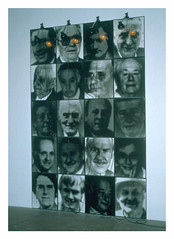In his most recent exhibition, French artist Christian Boltanski has set up a small recording studio where visitors can donate their heartbeats to the vast archive of the heart that the artist is currently building. Ultimately, the collection of heartbeats is to be stored on the uninhabited island of Ejima in Japan, which belongs to the art centre Benesse Art Site Naoshima.
There, it will be possible to access for anyone who feels the urge to listen to the heart of a beloved deceased, that is to say if the person in question was a donor, or simply contemplate over fugitive life. In more than one sense, Les archives du coeur is a continuation of Boltanski’s by now lifelong exploration of the ephemerality of human existence, or what the artist calls “small memories” as opposed to the kind of memories that make up our common historical references. The theme of irreversible loss, fading remembrance and eternal oblivion, which pervades works such as the The Children of Dijon (1986) and The Dead Swiss (1990) – see image below – is once again addressed here.

Those familiar with Boltanski’s work will also recognise his use of photographic portraits and naked light bulbs, albeit this time they’re not combined. Instead the portraits are sampled into one big projection, which shows fragments of faces shifting in furious speed. The light bulb in its turn, throws its swaying dim light over a dark room with nothing else in it except for the vigorous throbbing of a pulsating heart. What attracts most attention however is undeniably the possibility of donating one’s heartbeat to the archival record. This is carried out in a special room that is made to resemble a consulting office.

A white-coated “clinician” instructs you about the procedure, and after giving your informed consent the recording can take place, earphones on your head and stethoscope to your heart. Because it deals with a culturally emblematic organ as the heart, Les archives du coeur poses questions about contemporary biomedical archives, biobanks and databases in an oblique way. Can I be sure that my heartbeat will stay on Ejima and not be used in new inconceivable artforms? The exhibition is on until the 14th of December at Magasin 3 in Stockholm.
Archiving the beat of the heart
In his most recent exhibition, French artist Christian Boltanski has set up a small recording studio where visitors can donate their heartbeats to the vast archive of the heart that the artist is currently building. Ultimately, the collection of heartbeats is to be stored on the uninhabited island of Ejima in Japan, which belongs to […]


